Differential Analysis of Complex Systems of Herbal Medicines
Inquiry
Herbal medicines usually contain many compounds rather than a single active ingredient. Herbal medicine is a complex unknown system, and not all active ingredients of herbs are generally isolated, described, and quantified, so herbal systems not only have a large variety of compounds and an unclear number but also vary significantly in content and have few known compounds. The effect of a mixture of one or more herbs depends on the pharmacological activity of the mixture of one or more herbs. Even a plant is not a purely single compound. Conventional techniques for controlling single components may not be suitable for complex herbal systems. Lifeasible can provide efficient and sensitive separation and analysis of this complex black box system of herbs through chromatographic techniques and networked pharmacological research methods.

Ultra-performance liquid chromatography (UPLC)
UPLC is the fastest and best way to perform the work previously performed by high-performance liquid chromatography (HPLC) on large batches of complex herbal fractions, UPLC not only saves time but also increases efficiency and reduces solvent consumption. Moreover, UPLC can provide the best entry point for liquid chromatography for mass spectrometry, creating a good platform for analyzing complex systems of herbs.
- Reduced analysis time. The complex composition of herbs requires efficient separation and analysis of their complex components. Conventional HPLC generally requires more than 1h of sample components to be run to obtain a good separation. When using UPLC analysis, it only takes - half or even less time to get better analytical results.
- Increased peak capacity, increased sensitivity. For peaks that are not detected by HPLC or have minimal absorption values, the advantages of the high sensitivity of UPLC are even more obvious. Therefore, UPLC is essential for the study of trace and even trace components.
- Method conversion. UPLC and HPLC can be converted easily and conveniently. Analyses completed in 50 min by HPLC can be completed in less than 8 min by UPLC under the same separation conditions.
Network pharmacology
We have been able to better interpret the network action relationship between the multiple components of herbal medicines and the organism at the molecular level through a systems biology approach with the help of statistics, complex networks, and other mathematical tools. We use network topological properties to reflect the physicochemical and biological properties of herbal medicinal components, providing a new perspective to explore the complex mode of action from medicines.
 Figure 1. The basic idea of using network pharmacology to study the mode of action of herbs.
Figure 1. The basic idea of using network pharmacology to study the mode of action of herbs.
Herbal medicines often contain various chemical substances or active compounds with complex morphology, varying properties, and extremely small amounts. The interactions of these compounds are intricate, ranging from linear to non-linear changes, or between linear and non-linear changes, from chemical to biological changes. Lifeasible solutions allow the analysis and detection of the composition and content of these minuscule substances, allowing their complex structure or morphology, their biological activity, and their dynamic processes to be effectively and sensitively tracked or monitored. Please feel free to contact us for a tailor-made solution.
For research or industrial raw materials, not for personal medical use!
Related Services


 Figure 1. The basic idea of using network pharmacology to study the mode of action of herbs.
Figure 1. The basic idea of using network pharmacology to study the mode of action of herbs.